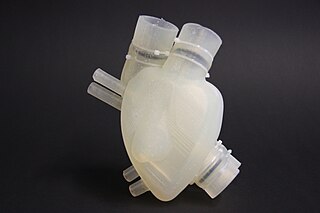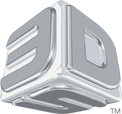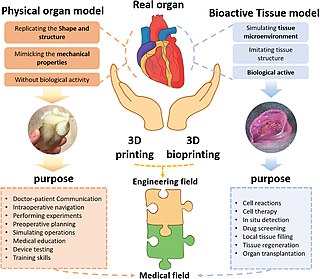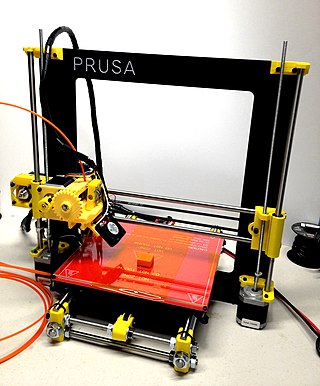Contour crafting is a building printing technology being researched by Behrokh Khoshnevis of the University of Southern California's Information Sciences Institute that uses a computer-controlled crane or gantry to build edifices rapidly and efficiently with substantially less manual labor. It was originally conceived as a method to construct molds for industrial parts. Khoshnevis decided to adapt the technology for rapid home construction as a way to rebuild after natural disasters, like the devastating earthquakes that have plagued his native Iran.

Stereolithography is a form of 3D printing technology used for creating models, prototypes, patterns, and production parts in a layer by layer fashion using photochemical processes by which light causes chemical monomers and oligomers to cross-link together to form polymers. Those polymers then make up the body of a three-dimensional solid. Research in the area had been conducted during the 1970s, but the term was coined by Chuck Hull in 1984 when he applied for a patent on the process, which was granted in 1986. Stereolithography can be used to create prototypes for products in development, medical models, and computer hardware, as well as in many other applications. While stereolithography is fast and can produce almost any design, it can be expensive.

3D printing, or additive manufacturing, is the construction of a three-dimensional object from a CAD model or a digital 3D model. It can be done in a variety of processes in which material is deposited, joined or solidified under computer control, with the material being added together, typically layer by layer.

Space manufacturing or In-space manufacturing is the fabrication, assembly or integration of tangible goods beyond Earth's atmosphere, involving the transformation of raw or recycled materials into components, products, or infrastructure in space, where the manufacturing process is executed either by humans or automated systems by taking advantage of the unique characteristics of space. Synonyms of Space/In-space manufacturing are In-orbit manufacturing, Off-Earth manufacturing, Space-based manufacturing, Orbital manufacturing, In-situ manufacturing, In-space fabrication, In-space production, etc. In-space manufacturing is a part of the broader activity of in-space servicing, assembly and manufacturing (ISAM) and is related to in situ resource utilization (ISRU).

Organ printing utilizes techniques similar to conventional 3D printing where a computer model is fed into a printer that lays down successive layers of plastics or wax until a 3D object is produced. In the case of organ printing, the material being used by the printer is a biocompatible plastic. The biocompatible plastic forms a scaffold that acts as the skeleton for the organ that is being printed. As the plastic is being laid down, it is also seeded with human cells from the patient's organ that is being printed for. After printing, the organ is transferred to an incubation chamber to give the cells time to grow. After a sufficient amount of time, the organ is implanted into the patient.

3D Systems Corporation is an American company based in Rock Hill, South Carolina, that engineers, manufactures, and sells 3D printers, 3D printing materials, 3D printed parts, and application engineering services. The company creates product concept models, precision and functional prototypes, master patterns for tooling, as well as production parts for direct digital manufacturing. It uses proprietary processes to fabricate physical objects using input from computer-aided design and manufacturing software, or 3D scanning and 3D sculpting devices.

Z Corporation is a company that makes 3D printing and scanning technologies. It was founded in December 1994 by Marina Hatsopoulos, Walter Bornhorst, James Bredt and Tim Anderson, based on a technology developed at MIT under the direction of Professor Ely Sachs. The Company was sold to Contex Holding in August 2005, and was ultimately acquired by 3D Systems on January 3, 2012.

Binder jet 3D printing, known variously as "Powder bed and inkjet" and "drop-on-powder" printing, is a rapid prototyping and additive manufacturing technology for making objects described by digital data such as a CAD file. Binder jetting is one of the seven categories of additive manufacturing processes according to ASTM and ISO.

Three dimensional (3D) bioprinting is the use of 3D printing–like techniques to combine cells, growth factors, bio-inks, and biomaterials to fabricate functional structures that were traditionally used for tissue engineering applications but in recent times have seen increased interest in other applications such as biosensing, and environmental remediation. Generally, 3D bioprinting uses a layer-by-layer method to deposit materials known as bio-inks to create tissue-like structures that are later used in various medical and tissue engineering fields. 3D bioprinting covers a broad range of bioprinting techniques and biomaterials. Currently, bioprinting can be used to print tissue and organ models to help research drugs and potential treatments. Nonetheless, translation of bioprinted living cellular constructs into clinical application is met with several issues due to the complexity and cell number necessary to create functional organs. However, innovations span from bioprinting of extracellular matrix to mixing cells with hydrogels deposited layer by layer to produce the desired tissue. In addition, 3D bioprinting has begun to incorporate the printing of scaffolds which can be used to regenerate joints and ligaments. Apart from these, 3D bioprinting has recently been used in environmental remediation applications, including the fabrication of functional biofilms that host functional microorganisms that can facilitate pollutant removal.
Construction 3D Printing (c3Dp) or 3D construction Printing (3DCP) refers to various technologies that use 3D printing as a core method to fabricate buildings or construction components. Alternative terms for this process include "additive construction." "3D Concrete" refers to concrete extrusion technologies whereas Autonomous Robotic Construction System (ARCS), large-scale additive manufacturing (LSAM), and freeform construction (FC) refer to other sub-groups.

Fused filament fabrication (FFF), also known as fused deposition modeling, or filament freeform fabrication, is a 3D printing process that uses a continuous filament of a thermoplastic material. Filament is fed from a large spool through a moving, heated printer extruder head, and is deposited on the growing work. The print head is moved under computer control to define the printed shape. Usually the head moves in two dimensions to deposit one horizontal plane, or layer, at a time; the work or the print head is then moved vertically by a small amount to begin a new layer. The speed of the extruder head may also be controlled to stop and start deposition and form an interrupted plane without stringing or dribbling between sections. "Fused filament fabrication" was coined by the members of the RepRap project to give an acronym (FFF) that would be legally unconstrained in its use.
voxeljet AG, which is based in Friedberg (Bayern) near Augsburg (Germany), is a manufacturer of industrial 3D printing systems. The company has been listed on the Nasdaq since 2020, and previously listed on the New York Stock Exchange since its IPO in 2013. In April 2024, the company delisted from Nasdaq and now trades OTC (OTCMKTS:VJTTY). Besides the development and distribution of printing systems, voxeljet AG also operates service centers for the on-demand manufacture of molds and models for metal casting in Germany, the USA and China. These products are manufactured with the help of a generative production method based on 3D CAD data.

In recent years, 3D printing has developed significantly and can now perform crucial roles in many applications, with the most common applications being manufacturing, medicine, architecture, custom art and design, and can vary from fully functional to purely aesthetic applications.

A variety of processes, equipment, and materials are used in the production of a three-dimensional object via additive manufacturing. 3D printing is also known as additive manufacturing, because the numerous available 3D printing process tend to be additive in nature, with a few key differences in the technologies and the materials used in this process.
Multi-material 3D printing is the additive manufacturing procedure of using multiple materials at the same time to fabricate an object. Similar to single material additive manufacturing it can be realised through methods such as FFF, SLA and Inkjet 3D printing. By expanding the design space to different materials, it establishes the possibilities of creating 3D printed objects of different color or with different material properties like elasticity or solubility. The first multi-material 3D printer Fab@Home became publicly available in 2006. The concept was quickly adopted by the industry followed by many consumer ready multi-material 3D printers.

3D food printing is the process of manufacturing food products using a variety of additive manufacturing techniques. Most commonly, food grade syringes hold the printing material, which is then deposited through a food grade nozzle layer by layer. The most advanced 3D food printers have pre-loaded recipes on board and also allow the user to remotely design their food on their computers, phones or some IoT device. The food can be customized in shape, color, texture, flavor or nutrition, which makes it very useful in various fields such as space exploration and healthcare.
Markforged Holding Corporation is an American public additive manufacturing company that designs, develops, and manufactures The Digital Forge — an industrial platform of 3D printers, software and materials that enables manufacturers to print parts at the point-of-need. The company is headquartered in Waltham, Massachusetts, in the Greater Boston Area. Markforged was founded by Gregory Mark and the chief technology officer (CTO) David Benhaim in 2013. It produced the first 3D printers capable of printing continuous carbon fiber reinforcement and utilizes a cloud architecture.

3D concrete printing, or simply concrete printing, refers to digital fabrication processes for cementitious materials based on one of several different 3D printing technologies. 3D-printed concrete eliminates the need for formwork, reducing material waste and allowing for greater geometric freedom in complex structures. With recent developments in mix design and 3D printing technology over the last decade, 3D concrete printing has grown exponentially since its emergence in the 1990s. Architectural and structural applications of 3D-printed concrete include the production of building blocks, building modules, street furniture, pedestrian bridges, and low-rise residential structures.
Luyten 3d is an Australian, Melbourne based, robotics and 3D printers manufacturing company, that designs and manufactures AI mobile 3D printers and 3D printing mix for the building and construction industry.
A 3D printed medication is a customized medication created using 3D printing techniques, such as 3D printed tablets. It allows for precise control over the composition and dosage of drugs, enabling the production of personalized medicine tailored to an individual's specific needs, such as age, weight, and medical condition. This approach can be used to improve the effectiveness of drug therapies and to reduce side effects.













